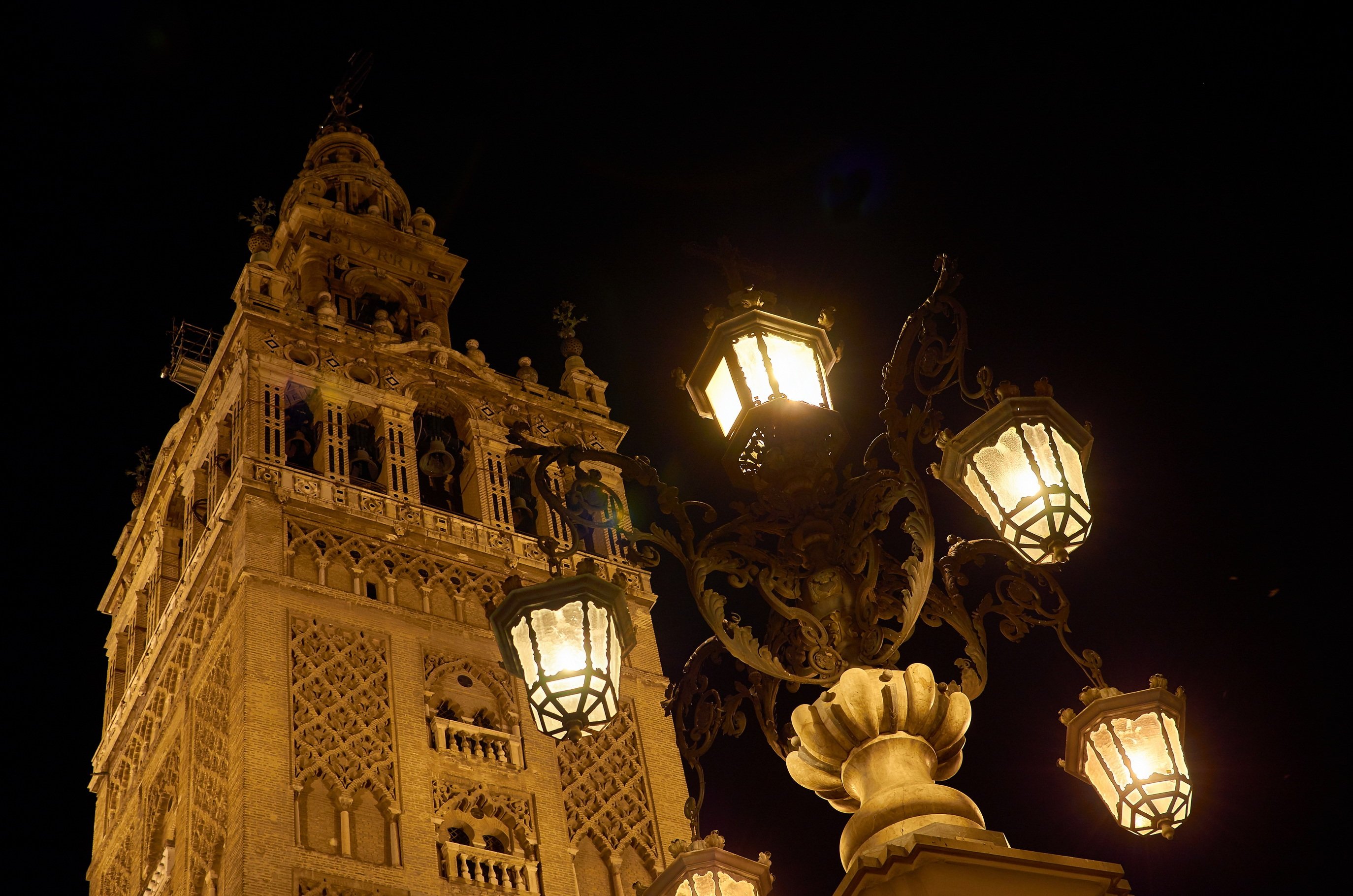
With the night as a backdrop, take a tour with us through the old Jewish quarter of Seville, a neighbourhood that has inspired poets and playwrights alike. Winding along the captivating alleyways and most important spots you will get to know the Santa Cruz neighbourhood in all of its splendour. You will surely be charmed!
Palace of the Archbishop Gateway
Located in the Virgen de los Reyes Plaza, the main entrance to the Palace of the Archbishop was built in the 18th century and is considered one of the most important architectural masterpieces of the Sevillian baroque period. The project was done by Lorenzo Fernández Iglesias and Diego Antonio Díaz. It was built under the sponsorship of the Archbishop Manuel Arias, whose coat of arms can be seen in the arch of the palace entrance. Once through the threshold of the doorway, there is a patio which gives way to the offices of the General Archive of the Archbishop and the Library.
Virgen de Los Reyes Plaza
This plaza is located in the historic city centre of Seville, as it is the area which unites such emblematic buildings as the Cathedral, the Palace of the Archbishop and the Convent of Encarnación. It is a pedestrian plaza, which numerous tourist groups pass through daily, some of which take advantage of the occasion to take a ride in a horse drawn carriage available and experience the city in a different way. Additionally, for special events like Holy Week or Corpus Cristi, the plaza plays a special role as a location where processions pass through.
Old Jewish Quarter of Seville
The origins of the Jewish Quarter of Seville date back to the times of King Ferdinand III of Castilla when he conquered the city which, at that time, Seville housed the second largest population of Jewish people in all of Spain, following after the namesake in Toledo. The Jewish Quarter was located in what are now the Santa Cruz and San Bartolomé Neighbourhoods and despite the expulsion of this community in the year 1483, part of the Jewish and Muslim population remained in the area throughout the years that followed.
Santa Cruz Neighbourhood
In the 19th century, this was a Jewish neighbourhood infamously known for being a breeding ground for diseases, where it was necessary to make urgent improvements. In that respect, the contributions made by Juan Talavera y Heredia alongside the journalist José Laguillo, united to awaken the city due to the inauguration of the Ibero-American Exposition in 1929, made it possible to reach a consensus in order to redevelop the Santa Cruz Neighbourhood. Nowadays, it is one of the most visited areas of the city for the charm of its narrow alleys and streets.
Doña Elvira Plaza
This lovely plaza is located in the Santa Cruz Neighbourhood and arose out of the aforementioned redevelopment that took place between the years of 1911 and 1918 in Seville. During the 17th century, it was the headquarters of the well-known corral de comedias (theatrical courtyards). The Doña Elvira Plaza was given that name because of the Sevillian legend that states it was home to Don Gonzalo de Ulloa, the father of Doña Elvira; two characters from the play Don Juan Tenorio by José Zorilla. This square has a sense of beauty and appeal of indescribable value.
Murillo Gardens
Up until the 20th century, the Murillo Gardens were the gardens of the Real Alcázar of Seville and were made public and open to visit when the mayor at the time, Conde de Halcón, ordered the transfer of these lands be made to the Spanish City. Later on, the municipal architect Juan Talavera y Heredia was put in charge of designing the structure of paths and roundabouts for these gardens and for that reason, they were originally called “The Talavera Gardens”. In the interior part of the gardens, one tower and some paintings of the old city wall are still conserved, where one can see the canals that connect the water from the Caños de Carmona up to the Alcázar of Seville.
The Santa Cruz Plaza
This is a medium sized, rectangular plaza located in the Santa Cruz Neighbourhood. In its centre, one can see a garden elevated by a few steps and surrounded by orange trees that offer nice shade when the sun shines strongest. Within the garden, there is a “Cruz de la Sierpes” (cross of the serpents), popularly known as “La Cruz de la Cerrajería” (locksmith cross) and made by Sebastián Conde in the year 1692. In its origin, it was devotional, as it commemorated the exaltation of the cross and was paid for by popular subscription.
Calle Mateos Gago
It begins in the Virgen de Los Reyes Plaza and flows out into Calle Fabiola and runs more than 250 metres in length, one of the most typical stamps of the city. Previously, it was known as the “Borceguinería”, as that was where the trade was in charge of producing and selling borceguíes, a type of boot used in Spain during the Middle Age. The “Borceguinería” was, at that time, narrow and destitute, which is why the brotherhood of Santa Cruz, whose headquarters were located at the end of the street, reclaimed the reconstruction, given that the processions had to move in an enormous circle to reach the official pathway during Holy Week. Finally, coinciding with the Expo of 1929, a number of houses were demolished and later the street was widened.
The Giralda
Currently, this is the second largest building in the city of Seville, after the construction of the Pelli Tower. As a fun fact, the Giralda has 35 ramps, because it was originally designed for the Sultan to ride up on horseback to see the incredible views of the city from the bell tower. In fact, this was used by Dan Brown in his novel Digital Fortress, which was set in Seville, although the author wrongly changed the ramps for stairs.
